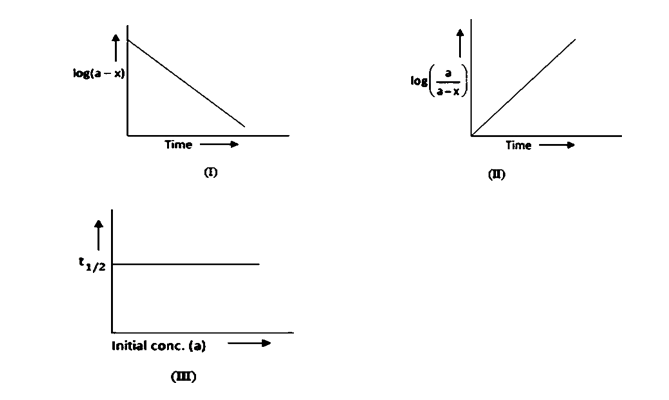For a first order reaction , the initial concentration of the reactant is [A]0 . How much time is required for the concentration of the reactant to decrease to decrease to [A]0e ? (Where e = base of natural log).Solution in Bengali
For a first order reaction , the concentration of the reactant time t is given by [A]t=[A]0e−kt,(k=rate constant).
If the concentration of the reactant at time 't1' is [A]1 , then [A]1=[A]0e. Therefore,[A]0e=[A]−kt10 or, e−1=e−kt1
or, kt1=1∴t1=1k
Topper's Solved these Questions
- BOOK - CHHAYA PUBLICATIONCHAPTER - CHEMICAL KINETICSEXERCISE - ADVANCED LEVEL NUMERICAL BANK16videos
CHEMICAL KINETICS
- BOOK - CHHAYA PUBLICATIONCHAPTER - CHEMICAL KINETICSEXERCISE - ENTRANCE Question Bank (WBJEE)9videos
CHEMICAL KINETICS
- BOOK - CHHAYA PUBLICATIONCHAPTER - CHEMICAL KINETICSEXERCISE - SOLVED NCERT TEXTBOOK PROBLEMS (NCERT EXERCISE QUESTIONS)44videos
CHEMICAL KINETICS
- BOOK - CHHAYA PUBLICATIONCHAPTER - BIOMOLECULESEXERCISE - Practic Set 291videos
BIOMOLECULES
- BOOK - CHHAYA PUBLICATIONCHAPTER - CHEMICAL THERMODYNAMICSEXERCISE - Practice Set 615videos
CHEMICAL THERMODYNAMICS
Similar Questions
A first order reaction A→B requires activation energy of 70kJ.mol−1 When a 20% solutions of A was kept at 25∘C for 20 min, 25% decomposition took place. What will be the percentage decomposition in the same time in a 30% solution maintained at 40∘C ? Assume that activation energy remains constant in this range of temperature.
View SolutionWhich one of the following is wrong about molecularity of a reaction—
03:54View SolutionFrom the rate expression for the following reactions, determine their order of reaction and the dimensions of the rate constants.
3NO(g)→N2O(g),Rate=k[NO]201:38View SolutionWrite down the structure of tripeptide Gly-Ala-Val.
02:17View SolutionThe condition for spontaneity of process is
04:18View SolutionAssertion: For a first order reaction, the concentration of the reactant decreases exponentially with time. Reason: Rate of reaction at any time depend upon the concentration of reactant at that time.
06:51View Solutionयदि एक प्रथम कोटि अभिक्रिया में भाग लेने वाले एक अभिकारक का प्रारम्भिक सांद्रण [A]0 है तो n अर्द्ध- आयु के पाश-चात अभिकारक की कितनी मात्रा रह जाएगी?
05:31View SolutionIn a first order reaction,the concentration of the reactants decreases…………………………..with time (linearly or eponentially or sinusoidally).
03:49View SolutionAssertion. For a first order reaction, the concentration of the reactant decreases exponentially with time. Reason. Rate of reaction at any time depends upon the concentration of the reactant at that time.
03:35View SolutionWhat will be the nature of the graph showing the concentration of the reactant and time of a first order reaction ?
01:49View SolutionHow does the initial concentration of the reactant in a first order reaction very with time ?
02:16View SolutionFor a zero order reaction, the initial concentration of the reactant =[A]0 and after time 't' from the initiation of the reaction, the concentration =[A] . What will be the nature of the graph of '[A]' vs 't,
02:51View SolutionWhich of the following is/are correct for the first order reaction ? (a is initial concentration of reactant, x is concentration of the reactant reacted and t is time)
 05:25View Solution
05:25View Solutionप्रथम कोटि की अभिक्रिया का वेग स्थिरांक 0.0051 min-1 है। यदि अभिकारक की प्रारम्भिक सान्द्रता 0.10M हो तो 3 घण्टे के बाद अभिकारक की कितनी सान्द्रता बचेगी?
View SolutionThe rate equation for a first order reaction is given by [R] = [R]_(0) e^(-kt) . A straight line with positive slope is obained by plotting [R]_(0) = initial concentration of reactant, [R] = concentration of reactant at time, t
04:08View Solution

